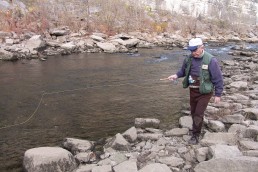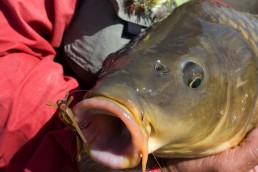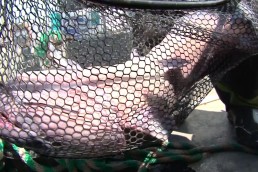Wading is an Excellent Way to Fish Streams
SHARE THIS POST
Anglers in Kentucky often learned to fish by wading the abundant streams that course over the surface of our state. Many of these streams flow over rocky bottom and hold substantial populations of smallmouth bass. Several streams flowing in the mountains of east Kentucky, or streams powered by springs, receive trout stocked by the Kentucky Department of Fish and Wildlife Resources.
Wading is arguably the best way to catch a big fish from one of these streams. Wade fishing boils everything down to its essence: you, your fishing rod of choice and the fish. You don’t worry about working a complex sonar unit, dead batteries, crowded lakes or navigating a boat ramp. All you need is at your fingertips so you can concentrate on catching fish, not distractions.
Paddling a stream is a great way to explore and fish, but promotes wanderlust as the mind conjures what is around the next bend. There is a time component involved as well, as you have to be at the take-out by a predetermined time, or at least before darkness falls. Wading anglers find they often catch bigger fish because its methodical nature promotes a peaceful mind and forces you to thoroughly fish a spot before moving on to a new one.
Stealth and safety are important considerations for proper wading. Stream smallmouths usually hang in the flowing water above and below stream drops, while stream trout locate toward the deeper water in the same spots. As you wade into the water, keep your feet low as you wade deeper. Firmly plant your front foot before moving the rear foot forward. Do not lift your foot too high, or the current will take it and you may lose your balance.
When wading against current, walk sideways to reduce water pressure on your legs, and go slowly. Consider the consequences of falling if you proceed into rough, questionable water. Nature doesn’t make soft, spongy rocks. They hurt when you fall and hit them.
A wading staff helps with balance, ascending or descending steep banks, and for probing the water ahead of you to test the depth. A thick hickory stick with a hole drilled through for a loop of paracord as a lanyard does just fine.
Wading anglers eventually will need to cross a stream. The shallow water in a stream drop makes the best spots to cross, but current makes this tricky. Approach the riffle or rapid from upstream and angle across downstream. Wading down and across the riffle is much easier to get to the other side than wading up and across.
If you get a quarter way across a swift riffle and the current makes you tipsy, turn back and find another spot to cross. If you cannot enter into a wading situation with confidence, do not do it.
At this time of year, you will need waders to combat the cold water. Breathable waders with a stocking foot make the best choice. Neoprene waders work well if you only trout fish cold tailwaters like the Cumberland River below Wolf Creek Dam.
Are you enjoying this post?
You can be among the first to get the latest info on where to go, what to use and how to use it!
For the other streams in Kentucky, neoprene waders, especially the 5-millimeter ones, will roast you. You can tell how far you’ve walked by the sweat rings in your hat when wearing neoprene waders in a normal Kentucky stream. Waders with boot feet work well for waterfowl hunting, but are uncomfortable for wade fishing.
Stocking foot waders require a pair of wading boots. Wading boots are designed to accommodate the neoprene stocking foot on this style of waders, so buy your normal shoe size and a neoprene sock. This sock fills in the gap of your neoprene booties for wet wading in summer. This allows you to use wade boots year round.
Avoid the water sandals with open toes, open sides and open heels. Wade boots have thick soles as well as toe and heel cups to offer fantastic protection for your feet. With the high water levels we’ve had the last couple of years, our stream bottoms may have some barbed wire fence, metal or glass in them. You could step on a broken bottle in a pair of wade boots and not feel it; the same scenario in sandals could lead to a nasty cut.
For decades, felt-bottomed wade boots were the standard, but newer rubber-cleated boots now make up a substantial part of the market. The soft rubber-cleated wade boots are a big improvement over the old lug-soled rubber boots. However, for sheer grip on rocky, algae-covered streambeds, nothing beats felt.
Kentucky streams often flow over limestone and feature long stretches of flat bedrock. Water flowing over these shelves over time carves undulations, resembling waves on water. There is no slicker bottom than these limestone shelves, especially after the sun’s rays promote a coating of algae. Felt bottom wade boots will save your bacon in situations like this.
A fishing vest makes keeping your lures, a pair of pliers, clippers and a bottle of water convenient. They are comfortable as well, but an inexpensive fanny pack will do in a pinch.
Remember to respect private property and always secure landowner permission before wading. Although streams are public resources, the land beside and beneath streams are private and thus require permission to access them, unless owned by a government agency. Elkhorn Creek in Franklin County is a noteworthy exception; wading is permissible to everyone, but getting to and from the water on private land still requires permission.
This spring is a perfect time to wade a stream.
MWO
SHARE THIS POST
Did you enjoy this post?
You can be among the first to get the latest info on where to go, what to use and how to use it!
Lee McClellan
Author Lee McClellan is a nationally award-winning associate editor for Kentucky Afield magazine, the official publication of the Kentucky Department of Fish and Wildlife Resources. He is a lifelong hunter and angler, with a passion for smallmouth bass fishing.



